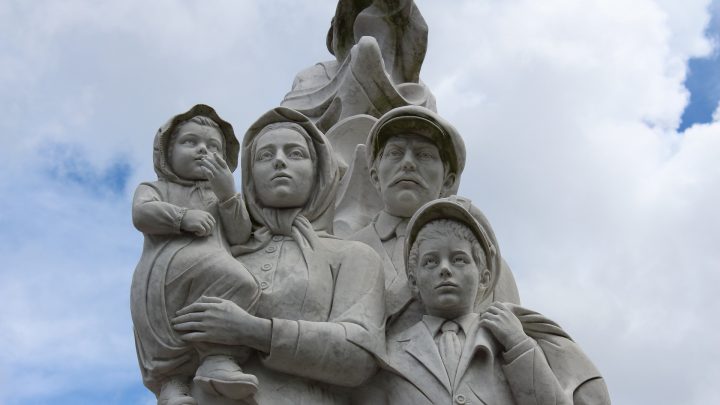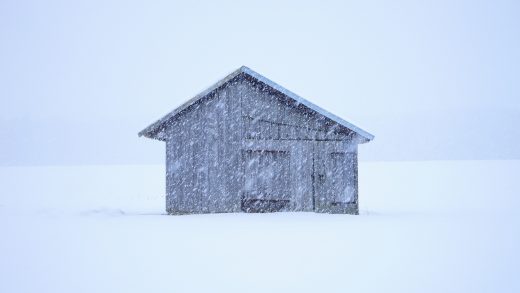I’m a quarter Swedish, almost half German and the rest is a mix of English, Irish, Scottish and French.
I know this because I am, like so many North Americans of European ancestry, fascinated by, and a little proud of, where our ancestors came from. We know the particular mix of nationalities that makes up our own mosaic, and maybe even when they came and where they settled. Some, like me, can even claim that our ancestors took part in the Revolutionary War, or were some of the first immigrants to an area. We think of them as the smart ones, the ones who sought out opportunities, a new life in the land of freedom. We think of them as exceptional, our own embodiments of the American Dream, fleeing the poverty and repression of Europe for freedom and a good life in America’s wide-open spaces.1
But now that I’ve moved back to Europe, away from my home and family, I’ve started to wonder why they left. Most of their compatriots did not, just as the majority of people in the world do not leave the area in which they were born. What would make my ancestors abandon all that was familiar to them and strike out into the unknown? What made them step on that boat? How were they able to wave goodbye, likely forever, to their families, their languages and the land that had formed them? Were they, in fact, in some way exceptional?
To make it more concrete, I decided to look through a very personal lens at what was happening when my various ancestors decided to leave their various countries to emigrate to the United States. What was life like where they came from? Was there a reason why they would move? Were they the only ones who left when they did? What was their journey like Where did they go to and why there? What was life like when they landed? And, of course, were they actually exceptional?
To start with, I’ve looked at the four families who passed their names down to my four grandparents, each of whom came from a different country at a different point in history.
Thomas and Anne Tupper, arrived 1631 from England
The first of these four to arrive in America was my maternal grandmother’s forefather, Thomas Tupper. He was an English Puritan from Sussex, in Southeastern England, who served as a carpenter on several ships going between England and the Massachusetts colonies in the 1620s and 1630s, spent a year or two working in the colonies, before deciding to settle in the New World.
Thomas was part of the Puritan Great Migration which took place between 1630 and 1640, when 80,000 English Puritans left, 20,000 of them to New England. Back in old England, it was a turbulent time for the Puritans. King Charles I was leading his country into the civil war in 1642 by cracking down on those who disagreed with the church and dissolving Parliament in 1629 to silence his critics, including many Puritans. However, while the Puritans were facing religious intolerance, and while some of the early colonists were driven by the desire for religious freedom, they did not face danger to life and limb in England. Most of those who came over in that period were in fact middle-class seekers of economic opportunity, tradesmen and craftsmen like Thomas, who had the means to pay for passage. And Thomas, even though he cited his need to obtain “liberty of conscience” as his reason for immigrating to the colony, definitely found his economic opportunity.
He settled in the Plymouth Colony with his third wife, Anne, and was one of the ten founders of the Town of Sandwich in 1637, the first town on Cape Cod. He became a pillar of the community, serving in many civic positions and as a lay preacher, and was known for dealing fairly with the Native Americans. His son Thomas married Martha Mayhew, the Governor’s daughter, and the namesake of Martha’s Vineyard.
Thomas Senior’s descendants spread out throughout Canada and the States and include such luminaries as Sir Charles Tupper, Taylor Swift, the founder of Tupperware, Bill Nye and Bill Gates. My own ancestors moved back and forth between Nova Scotia and Massachusetts, before my great-grandfather moved west, acquiring a bride from Arkansas. He was a hotel manager in Cape Girardeau, Missouri, where my grandmother grew up, before going to university in Spokane.
Heinrich and Magdalena Wuhrman, arrived 1735 from Switzerland
My paternal grandmother’s ancestors were the next to arrive, leaving Wiesendangen, Switzerland (near Zurich) in 1734. Heinrich Wuhrmann, a farmer who became Henry Worman, came with his brother Johannes (John), a wagon master, and their wives and children. They followed the Protestant Reformed faith and were likely part of a group recruited by a Reverend Goetschy, who led a group from the Zurich area earlier that year. That earlier group had a tumultuous journey down the Rhine, between the warring armies, in order to get to Rotterdam, where they boarded a ship for a long and uncomfortable journey to Pennsylvania.
The Goetschy group were originally headed to Carolina but changed their destination at the last minute when Goetschy was offered a church. They joined thousands of other German speakers from various states in Germany, Switzerland and Alsace who emigrated to that colony between 1717 and 1775, becoming the Pennsylvania Dutch (who are actually German). This wave of German settlers were mostly not fleeing severe religious persecution or agricultural disaster, but were rather were part of an outmigration of hundreds of thousands in this time, reacting to overpopulation and land scarcity and heading to many different destinations.
Within a few years, Henry and his family were settled as farmers and church deacons within the Pennsylvania Dutch community, and their descendants married other German immigrants and spent the next couple centuries farming in the same region. Some were still farming in the time of my great-grandparents, who both died young, my great-grandmother of disease and my great-grandfather a few year later from some bad alcohol during Prohibition, leaving my grandmother with less-than-loving relatives and her siblings on one of those farms.
Ludwig and Mary Magdalena Volz, arrived 1850 from Germany
My paternal grandfather’s ancestors were also German speakers, this time from Bietigheim, in what was then the Grand Duchy of Baden and is now in the German state Baden-Württemberg. Ludwig Volz and Mary Magdalena Volz were a young couple, first cousins, who left with a group of young people from their village in 1850. I believe they sailed from the new port of Bremerhaven, established by the City of Bremen in response to its waterways silting up. Bremerhaven did a good business in emigration, sending a sizeable proportion of the 7.1 million Germans who left between 1820 and 1870.
At that time, the Baden region of Germany had been through many years of war, with various armies going back and forth over the land and changing the religion of the inhabitants each time. There was also little land available, as Germans split the property between all the children instead of it all going to the eldest, which made the plots of land smaller and smaller. There was little economic future in the area, so they left.
In Philadelphia, the Volzes got married and became the Folz family. There they intermarried with other immigrant groups: their son married an Irish woman and their grandson, my great-grandfather, married a French woman whose parents left Alsace Lorraine in 1870, the year the Germans took it over. This grandson was a doctor, and his brothers were dentists and doctors, so they were upwardly mobile, at least until the Spanish Flu, which hit Philadelphia hard. My great-grandfather and one of his brothers were two of the victims, and my young great-grandmother was left a widow with seven young children. She remarried but by all reports her husband did not treat his stepchildren well, setting up yet more family trauma.
John Erickson and Anna Elise Larson, arrived 1887, and Helmer Sandström, arrived 1906, from Sweden
My maternal grandfather’s parents were the last to arrive. Both were Swedish, but from different areas of Sweden and in slightly different eras. My great-grandmother’s parents both came from southern Sweden, her father from Värmland and her mother from Småland, both in 1887. They were just two of the 50,000 people, or 1% of the entire Swedish population, who left for the US that year.
It was one of the tallest peaks in the waves of the great Swedish migration that took place between 1850 and 1939, when nearly 1.5 million people left, the vast majority for America. It was a time of change in Sweden: there had been land reform that pushed more people from their villages in the early 1800s, and like the Germans, the Swedes divided the inheritance between all the children, including women from 1845. In addition, peace, the smallpox vaccine, hygiene and the potato meant that the population had practically doubled between 1750 and 1850 (from 1.78 to 3.48 million) and was continuing to grow rapidly, reaching 5.14 million in 1900. This meant that farmers were trying to farm ever shrinking pieces of land and more people had no land at all in a time with several crop failures. This was especially true in the areas my great-grandmother’s parents came from.
Steamships had started transporting the immigrants in the late 1860s, which cut both the time and the cost of travel. Previously, most immigrants had been families, but now travel was also accessible to young single men and women, like John Erickson and Anna Elise Larson. They met and married in Chicago within two years of landing, quickly moving to the Scandinavian stronghold of Minnesota, where my great-grandmother Agnes was born. The family moved to Spokane around 1912, where Agnes eventually met my great-grandfather.
Helmer Sandström was the only one out of my eight great-grandparents not born in the US. He came from a small settlement near Umeå, in northern Sweden, the youngest of 12 children of a blacksmith, who died when Helmer was only nine. One of his brothers, Olaf, had emigrated to the US in 1895, accompanying their sister Augusta and her children to meet her husband in an Olympic Peninsula logging camp, where he had gone the year previously. Unfortunately, the husband died in a logging accident two years later, so Augusta returned to Sweden, leaving her oldest daughter behind. Olaf moved to Spokane and started a blacksmith shop. He came back for a family visit to Sweden after 10 years and when he returned to America he took his almost 18-year-old brother back with him. Another sister followed a few years later. Helmer established himself as a salesman in Spokane, met Agnes and had three children, including my grandfather, who eventually became an English professor in San Diego.
Were they exceptional?
Not really. As I looked at all of these stories, what struck me was that none of them fit the myth of America. They were not the tired or poor, or the huddled masses yearning to breathe free. They certainly were not wretched refuse of anyone’s teaming shore. None of them were refugees, fleeing in danger for their lives, with nothing but the clothes on their backs. All of them were economic migrants who made a choice to move, to find a better life for themselves and their descendants, while most of their family stayed behind. They certainly weren’t rich, but they had the means to get to America and begin their lives there. Some of them had specific desirable skills, like carpentry or blacksmithing, but they were not highly educated or bearers of unique skills.
I also found that none of them were trend leaders. All of them came as part of a wave of emigration, times when people’s natural inclination to stay where they are changes and emigrants move in groups to where they hope to find better lives. These are usually times of stress in a certain area, stress due to wars, politics, religion and/or demographic pressure. My ancestors all left where they were due to one or more of these pressures. And by moving as part of a wave, they knew that they would find others like them where they were going, others with the same language and the same religion. They were going somewhere new and mostly unknown, but they knew that they would not be alone and that some of their familiar life would greet them when they got there.
Naturally, my ancestors’ stories to not encompass all of the stories of those became Americans. They are limited to a few countries of origin and a few parts of North America. They don’t cover the stories of a few who were in fact rugged individualists or visionaries. Nor do they cover those who had no choice in coming, those who were dragged to the Americas as slaves from Africa or as indentured labour from China. Nor are they the stories of those who were actually refugees, fleeing famine or the horrors carried out in various places around the world. And nor do their stories include those of the people who were already there, those who my ancestors helped to displace and destroy.
But I think that my ancestors’ stories do in a broad sense encompass many of those who immigrated to the United States of America from Northern and Western Europe before the mid-20th century, what drove them to move and what they found when they got there. They were, after all, each part of a massive wave, and these waves all spread out and mixed, spreading their members over the continent. As parts of those waves, my ancestors’ stories may not be exceptional, but in their unexceptional stories and the snapshots of their journeys we get a sense of America’s less mythic history, which is a history very worth telling.
Of course, the spaces were not unoccupied, and this ignores our role in what happened to those who were already living there, but I’m referring to the popular myth.↩






I enjoyed this story and learned more about my family’s history and arrival to america my grandfather was Harold Farin Tupper your grand mother’s father
Very cool! Nice to meet you this way.